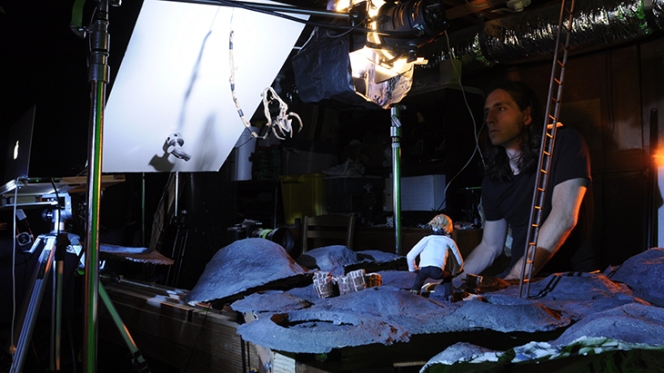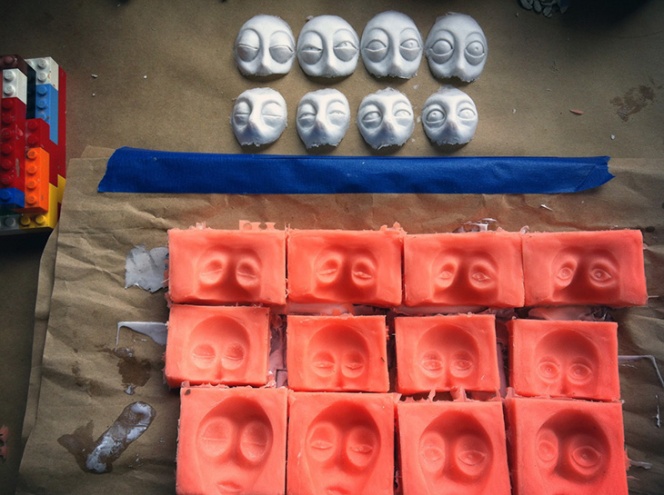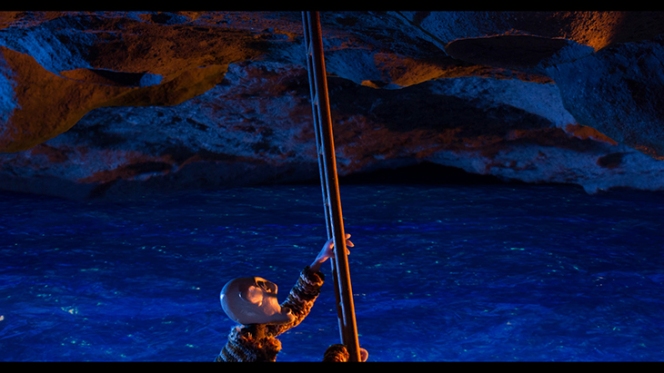Your Cart is Empty
Recent Articles
- Efficiency Meets Innovation: SketchUp 2024 Unveiled
- Maxon One Spring 2024 Release Packs Particle Power, Toon Shading, and More
- TurboCAD 2024 Unveiled by IMSI Design: Discover the New Features and Enhancements
- Exploring the Latest InfraWorks 2025 Updates
- Introducing the Latest Innovations in Autodesk's ReCap Pro 2025
- Discover the Latest Enhancements in Civil 3D 2025
- Exploring the Newest Features and Enhancements in Revit 2025
- Explore the Latest Features in Vantage 2.3 Update
- Explore the Latest AutoCAD 2025 Enhancements: Activity Insight, Smart Blocks, and Apple Silicon Support
- Unveiling Enscape 4.0: Revolutionizing Design with Unified Experience for macOS and Windows Users
The Edge: Ri’s Moon Milk
June 10, 2014 7 min read

Novedge: Tell us a bit about who you are and what you do
Ri: My name is Ri Crawford, I am a stop motion animator and filmmaker, living in Oakland, California. I grew up in the hot, humid, reptile-laden south where both of my parents and both of my sisters were visual artists. Pursuing a Master's degree in electronic music composition at Mills College, I moved to California 10 years ago, vowing to never return to the Southeastern summertime heat. Now I kind of miss it. For the past six years I've worked professionally in film post-production finishing mostly documentaries and doing motion graphics work, occasionally still writing music, obsessing nights and weekends over my current stop motion project.
Novedge: What is or has been the biggest influence on your work?
Ri: I'm not sure I could cite one, aside from the constantly creative relationship I had with my mom as a kid. Rather than single out a superlative, I'll cite the sum-total of all the small things I encounter that trigger some kind of thought adventure. Black holes, movies, the ultraviolet radiation of Nepenthes pitcher plants, the usual interactions with other humans, culture, politics, the illustrations of Ernst Haeckel, and music, all influence what I do. Everything is really always amazing, outrageous, horrifying, and beautiful- we all stay focused for the most part so as not to get overwhelmed, but there's no shortage of fodder for the imagination. Ideas inevitably arise from pondering other ideas which then lead down unavoidable creative paths. Years ago, I became fascinated with the sounds of frog vocalizations and composed an album of music using recorded samples of their amorous songs. Lately I think a lot about Saturn's moon Enceladus. I've also been a part of Phil Tippett's Mad God crew for the past couple of years, which from every possible practical angle has been influential.

Novedge: Can you talk about your creative process? How do you approach each project?
Ri: By getting completely obsessed, utterly, thinking about nothing else… And then, very significantly, the creative process for me involves interacting with and responding to the materials I'm working with, be they images, clay sculptures, recorded sound, etc. Having my hands, eyes and ears on the raw material informs what to do with it, which is very often not what I thought I was doing at the moment. So I generally spend a lot of time experimenting with ideas and whatever I collect and make, trying to refine a visual style and develop techniques. For my current project, I got started by making composite images in Photoshop and After Effects. The early tests looked nothing at all like where I finally wound up, but were important to construct the language and vocabulary of the piece. And for a stop motion project, each piece of the puzzle is heritable to the next step such that by the time I was ready to begin shooting much had already fallen into place. Of course the camera changes everything, and the experiment renews with each setup, and eventually, one develops an arsenal of techniques to try, to see what's revealed.


Novedge: What is a recent project that you worked on?
Ri: My current project is a stop motion animated short called “The Moon's Milk”.
I'm three years into it now, and the film is currently just over 6 minutes long (out of approximately 20). It's set at a time, 3.7 billion years ago, when the Moon was accessible by ladder, and the prototype humans inhabiting the planet took advantage of this proximity to collect milk that oozes out of the Moon's craters. The characters, naturally, encounter the usual fits of jealousy, love, embarrassment, heroics, mischief and inebriation common for humans, all under these extraordinary circumstances.

I began the project by machining the armatures for the main characters, designing and casting their faces and hands, building sets and other props, and working feverishly on tests to establish the production's design. Many of the props and set pieces took several months to make. The “large” moon, for example, is a six foot diameter disk made of toilet paper and Elmer's glue and occupied weeks and weeks of my time, sculpting with wet toilet paper.

After just over two years, most of my props, sets, and characters were complete and I was able to start shooting frames which, as an animator, provides the magical payoff of experiencing handmade inanimate object come to life. I'm making this film in my basement, which after a lot of refinement is actually a respectably functional studio and stage, but it's also really small. I've clocked my head on bare light bulbs more than anyone should in a lifetime. As a result of these spacial limitations, I decided I was going to have to shoot a lot of the film against a green screen to convey the sense of space and mass implied by the open sea and the lunar surface. It's working pretty well, although I did indulge weeks and weeks of rehearsal and tests during which time I learned how to take advantage of the studio with regards to geometry.

Novedge: What does your workflow look like? What software do you use?
Ri: The workflow for stop motion begins way before you actually start to see anything – making all of the practical props, characters, and sets. Arts and craft skills are essential at this phase and you have to wear a lot of hats: sculptor, drawer, mold-maker, painter, improviser… Once everything is ready, set up, lit, etc. for animation, the process of shooting begins. As grueling as a stop motion shoot can be, there is something very freeing about the necessary commitment to each frame. It's really very difficult to undo something, once you've gotten a couple of frames in. So, each and every frame, regardless of the obscene amount of planning, rehearsal, and preparation, becomes kind of like an improvised musical moment. You have to commit to move on to the next frame, each subsequent one becoming a record of an instance of time, a unique configuration space, that you are then stuck with. Nevertheless, there is still an infinite minutiae of computer tweaking to finalize a shot.

I shoot raw frames on a Canon camera controlled with Dragonframe- the camera records ostensibly 5k images. I'll then import the frames as an image sequence into After Effects for comping. Most often I'll use Keylight to pull green screen mattes, then composite the practical layers I've shot from my library of backgrounds and elements. There is a component of sea creatures in the Moon's Milk, geo-synchronously hovering around- trapped within the mutual gravities of the Earth and Moon, which I create using tiny stop motion elements as sprites, deployed with Trapcode's particular. Once a shot is comped, the workflow proceeds in a traditional film post-production style – the shots are assembled into an edit in Avid, then “onlined” using 4k frame sequences also exported from After Effects, then finished and graded using DaVinci Resolve.

Novedge: What was the biggest challenge and what have you learned from it?
Ri: The biggest challenge to making a stop motion movie is mustering the discipline and motivation to do it at all. It's extraordinarily grueling work, and even a short stop motion film is an amalgamation of 4,973 individual art projects – each of which must be finished and committed to before you can think about photographing the animation. So I might be incredibly proud of the fully articulate-able starfish puppet I spent 4 weeks making, but it's a tiny element of the whole. Stop motion is all about detail and subtlety and how to exploit both within the practical confines of space, time and gravity. It can be rather overwhelming. Making those daily minute commitments is massively challenging, especially having grown up with computers where you can tweak things endlessly.
What I've learned is to get excited about, even rebelliously cherish, the moment at which you abandon a thing – a puppet, a set piece, some minor detail, eventually the actual shots in the movie – and move on to the next. Check it off of the list, as it were. This, by the way, is the best possible way to avoid the trap of a lifetime of minor improvements to something you made versus making a new thing that's even more impressive.

Novedge: What's next for you?
Ri: Its too soon yet to say what's next exactly. The Moon's Milk will easily occupy another obsessive year of my life. So the specific, immediate answer is the next shot. Today, that would be shot FT042. I am about ten or so shots away from finishing a scene that will account for about four minutes of the film. Practically, I've got to indulge the fundraising/producer activities necessary to pull something like this off. Once the film is done, I intend to make the festival circuit, win all kinds of awards, and then make another one. I have a journal of ideas born out of the process of making this film: puppets, scenarios, and techniques that have no place on the Moon. What I'd love to do is enlist all of the friends I've made working on the Moon's Milk – fabricators, animators and computer artists – at the beginning of the next project such that it's more of a collaborative endeavor from the start. But for now, I've got to get back down into the basement.
See more of Ri's work for The Moon's Milk on his website. Follow him on Vimeo, Twitter, Facebook and Instagram.
To keep up to date with Novedge's interviews, make sure to follow us on Twitter.
Related articles
Also in NOVEDGE Blog

Maxon One Spring 2024 Release Packs Particle Power, Toon Shading, and More
April 10, 2024 4 min read
Read More
TurboCAD 2024 Unveiled by IMSI Design: Discover the New Features and Enhancements
April 10, 2024 2 min read
Read MoreSubscribe
Sign up to get the latest on sales, new releases and more …






